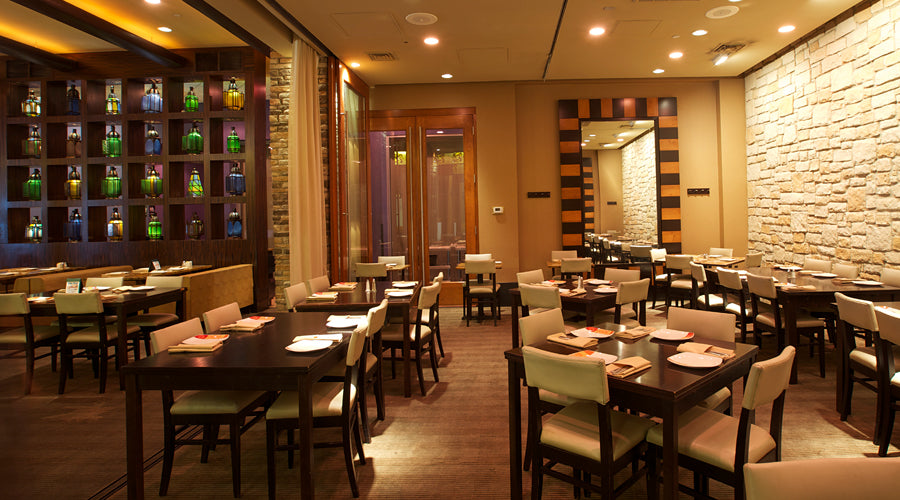
Every restaurant’s dining room should be unique. It may not seem obvious, but the layout and organization of your dining room supports your branding and subtly influences your customers spending. So be sure that your dining room and seating layouts are strategically designed.
Dining Room Layout: Before designing the layout of your tables and seating, you first need to consider your space limitations and decide how many separate dining spaces you will to create.
If you have not yet decided on the architecture of your dining area or plan to renovate the existing architecture, you can divide your space up in the following ways
Multiple main dining areas: You can create multiple dining rooms that flow into each other. Dividing up your dining areas with walls will make it easier to anchor tables. To add an individual charm to each space, you can design each room differently.
Open main dining area. You can use a single, large open dining space. Visually and acoustically, this will tend to add an edge of excitement to your dining room, since customers will be able to hear and see all other parties. This kind of space is ideal for floating tables, tables that are not near walls or other fixtures, but you can also add columns to create anchored seating, as well. The columns will have the added effect of enhancing the acoustics in the room.
Private dining rooms. You can close off a section or two with double doors, and designate that space as a private dining area. You can use one of the rooms as a smoking area, if local laws allow it. You can also rent out private dining rooms to large groups that want to hold private parties or meetings at your restaurant. If the rooms are not reserved, you can open the double doors and free up the space for walk-in customers.
Make sure each “area” you create will fit the number of tables and other furniture that you want in that space. If your dining room walls are already built and you will not be renovating them, you have to work with what you have. If you are set on having multiple dining areas but cannot afford to renovate your walls, you can use curtains, screens or partitions to create separate dining “rooms.”
Seating Layout
Once the architecture of your dining area is set in stone, follow these steps to create a seating layout:
Draw a map of the dining area. Measure the area and draw up a blueprint of the space. Include walls, columns, partitions and any other obstructions in your blueprint. You will use the blueprint to lay out your seating, tables and any other furniture in your dining room.
Determine the space between tables. For quick service, there can be less space, since waiters will not be moving much around the dining area. For a casual service restaurant, balance seating capacity with customer and server comfort. Consider the “feel” you hope to create. An “exciting,” casual atmosphere can be a little crowded. With a fine dining restaurant, tables should be spaced further apart to give the diners extra comfort and privacy.
Think about party size. Depending on your restaurant type, you may be serving large parties. If you will be expecting large parties, you will need a couple of large tables. If you are not sure what size of parties you will serve, it is a good idea to create a flexible seating layout with extra two-person tables that can be put together or pulled apart to accommodate different party sizes.
“Anchor” some of your seating. The large majority of people prefer to sit at a table that is “anchored” to a wall or a partition, rather than one that is floating in the middle of the room. Furthermore, people spend more money when they occupy anchored seating, although this is partly compensated for by the fact that they also linger longer after finishing their meals. Create seating anchored to the following:
Walls
Nooks
Partitions or screens
Columns
Curtains
Booths encourage the highest spending per minute, while tables near a wall or corner also have a high spending-per-minute value. The worst kind of anchored seating to encourage spending is banquette-style seating, where a long bench is set against a wall to be used as the seat back.
Strategically place floating tables. You can encourage high turnover with strategically placed floating tables. Guests spend less time lingering at tables near busy areas, like the kitchen or the exit, but they spend about the same average on their checks. Thus, the tables that are exposed to high traffic, the “bad” tables, are often the most profitable, earning more dollars-per-minute per customer. However, keep in mind that this will affect the customers’ memories of their dining experiences. While exposed, “floating” tables are often more profitable, they are less likely to encourage customers to come back again.
Studies of spending-per-minute at different table locations suggests that it is not necessary to go out of your way to get rid of all the “floating” tables. On the other hand, anchored tables are a key element in making diners feel comfortable and emotionally attached to your restaurant. In the end, the most profitable way to arrange tables is a mix of anchored tables and free-standing tables near high-traffic areas that can be mixed and matched to accommodate different party sizes.

